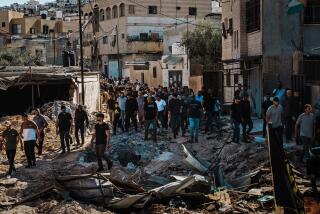Syria: Residents return to devastated Homs to salvage what remains
The people of war-battered central Homs came Sunday to salvage what remained of their belongings and homes after years of conflict and siege.
A deal finalized last week led to the evacuation of some 2,000 rebel fighters from the historic Old City, allowing many residents and shop owners to return for the first time in two years. What they saw shocked many.
The once-bustling heart of Syria’s third-largest city is now an apocalyptic jumble of bombed-out buildings, bullet-sprayed store-fronts and rubble-strewn streets and alleys. Shelling, aerial bombardment and gun battles have taken an extraordinary toll. The pungent smell of smoke is still evident.
Returnees often found little beyond devastated residences and looted businesses and a few tokens of their former existence. But they grabbed what they could, stuffing what remained of their former lives into baby carriages, suitcases and plastic bags and onto bicycles and scooters to take to their new homes. The neighborhood remains largely uninhabitable.
The brisk traffic of former residents and their meager belongings clogged the battered streets.
“It’s not much, just a few small things,” Rafi Sepechian said as he and his wife lugged several chairs, a floral print and a suitcase full of odds and ends from their former flat in the Old City. “It’s badly damaged, but we plan to rebuild. We love our home.”
Thousands have been making the trek in recent days since the rebels exited the sprawling area and it was declared safe. On Sunday, an almost festive air was evident, despite the sense of disbelief and gloom at the utter scale of the destruction. Homs’ war-weary residents seemed keen to show their resolve and will to get on with life. Many voiced the hope that the more than three-year conflict could be winding down, though the war grinds on in many parts of Syria, including Homs.
Christians, who formed a significant part of the Old City population, held a celebratory Mass at the renowned Our Lady of the Belt Syriac Orthodox Church, which was badly damaged but is still standing. The church is known for a venerated relic said to be part of a belt associated with Mary, the mother of Jesus. At the start of the fighting, clerics removed the relic, precious icons and other valuable items for safekeeping. Looters later dug up the spot below the altar where the relic was kept, priests said, but the item had been safely spirited away by church officials.
“I know there is damage, but this is the happiest moment in my life, to be back in the church where I was baptized and my son was baptized,” said Sawsan Hanoon, 40, standing in the debris-filled patio of the church. “We will rebuild it with our own hands.”
A few blocks away, mourners came to pay respects to the grave of Father Frans van der Lugt, a 76-year-old Dutch Jesuit assassinated by an unknown masked gunman last month on the grounds of the Jesuit residence. He had refused to leave the district where he had lived for decades after the rebels took control.
The late Jesuit was often seen on his bicycle, bringing food, medicines and other aid to the needy in the besieged district. Friends said he disregarded the constant danger in his bid to help residents regardless of their creed. He is buried beneath a tree in the garden of the church. For many, Sunday was the first opportunity to visit his grave, which has become a shrine to the slain Jesuit.
The spot where he was shot dead, a few yards away from his grave, was marked by a simple plastic chair adorned with some plastic flowers.
“We all learned so much from Father Frans,” said Mazen Kounnuwaty, 50, an engineer who remained in the Old City until February, losing more than 70 pounds because of the lack of food. “He never threatened anyone, only helped people of all sects. Why he was killed we still don’t understand.”
In the adjacent Khaldiya district, where the fighting has destroyed much of what was once a vibrant residential neighborhood, residents were also able for the first time to gain access to their homes and to the area’s major landmark — the majestic mosque of Khalid ibn al-Walid. The soaring structure features a pair of minarets and silver domes that once dominated the area vista. Many residents considered the mosque’s namesake, a companion of the Islamic prophet Mohammed, to be a guardian of Homs.
During the Syrian conflict, artillery shells made direct hits on several of the mosque’s domes, leaving gaping holes open to the sky. Inside, bullets gouged out chunks of the wall and there was also fire damage. But the mosque’s essential structure remains intact.
“It’s very confusing and troubling to see this,” said one visitor, a young woman studying to be a teacher who asked that her name not be used for privacy reasons. “We in Homs are fed up with war. I wish we could all shake hands and go back to where we were before. But it’s not so easy.”
More to Read
Start your day right
Sign up for Essential California for news, features and recommendations from the L.A. Times and beyond in your inbox six days a week.
You may occasionally receive promotional content from the Los Angeles Times.






